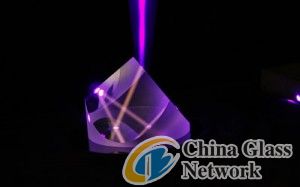Post Time:May 09,2013Classify:Glass QuotationView:861
 "Anti-reflective coatings reduce unwanted reflections from smooth surfaces that cause glare and glint, and can increase the optical power transmitted to underlying optoelectronic devices like solar cells and optical sensors," says Dr. Roger Welser, Chief Technology Officer at Magnolia Solar.
"Anti-reflective coatings reduce unwanted reflections from smooth surfaces that cause glare and glint, and can increase the optical power transmitted to underlying optoelectronic devices like solar cells and optical sensors," says Dr. Roger Welser, Chief Technology Officer at Magnolia Solar.
Magnolia Solar is one company that is hard at work on developing the next generation of anti-reflective coatings. These coatings are used on optics of varying types, but one industry that is much in need of such coating is the photovoltaics industry. As a key technological challenge is to improve solar cell efficiency, reducing reflection is imperative. This is because any sunlight that is reflected off of a solar module does not reach the solar cells and therefore does not contribute to energy output. Without proper coatings, up to 4% of light is reflected off a glass cover, and that means that light is lost and cannot be turned into electrical energy.
The quest to reduce unwanted reflection has triggered a number of innovative research and development efforts to develop anti-reflective coatings.
ARC - University of Florida
One interesting example comes from the University of Florida, which has created anti-reflective technology based on the structure of moth eyes. As Dr. Peng Jiang, Associate Professor at the Department of Chemical Engineering, University of Florida, explains, moth eyes have a 'periodic subwavelength structure' made up of regularly spaced nipple structures. Moth eyes are very dark and this coloration is not due to any pigmentation but rather to the corneal structure of their eyes.
"Our technology can mimic these structures onto various substrates, resulting in reflection suppression," says Jiang.
The technology was developed to overcome some of the shortcomings of 'traditional' quarter-wavelength silicon nitride or titanium dioxide coatings on silicon structures like PV modules. According to Jiang, moth-eye structures exhibit 'broadband' anti-reflection compared to these traditional dielectric coatings.
Researchers at the University of Florida have created anti-reflective technology based on the structure of moth eyes.
"The moth-eye structure can be made into the substrate itself. We use bottom-up colloidal self-assembly in making these structures. This allows for the development of processes that can be scaled-up. Our technology also works on a variety of substrates, including mono-crystalline and poly-crystalline silicon, gallium arsenide and glass," he says.
Sharp announced that they had developed displays based on the moth-eye principle last year, but Jiang says that these structures aren’t used in production PV cells as yet. However, cells produced using similar structures have been produced and show improved efficiency - and Jiang is now actively exploring further commercialisation opportunities.
DSM Innovation Center
Meanwhile, Netherlands-based company DSM Innovation Center has developed a nano-porous coating technology known commercially as KhepriCoat. The coating was initially tested and marketed for use in picture frames, before an optimized version was developed for solar applications.
"Anti-reflective coatings reduce unwanted reflections from smooth surfaces that cause glare and glint..."
Leo Smit, Branding and Communications Director at the DSM Innovation Center, explains that, by creating "nano-porous air-gaps" in the very thin coating-layer, the "refraction-index" goes down.
"In essence, our technology creates a series of 'nano-pores' in a solid coating that results in a closed surface and a very good adhesion to the glass cover," says Smit.
Following its recent acquisition of Solar Excel, the company is also developing a novel light trapping technology, which Smit says enables light to be trapped inside the module and not reflected back outside, thus increasing the efficiency.
The light trapping technology is still under development - but the KhepriCoat coating is a commercially available product and Smit says that the coated glass is 'being used by numerous solar module producers around the world.'
Magnolia Solar
In the US, Magnolia Solar, which is based in Woburn, Massachusetts and Albany, New York, has also developed a "broadband nanostructured anti-reflection coating," initially developed alongside the Defense Advanced Research Projects Agency (DARPA) and the New York State Energy Research and Development Authority (NYSERDA).
Welser explains that, by engineering the optical properties of coating materials, Magnolia's advanced nanostructured optical coatings "are able to reduce reflections over a broad spectrum and a wide range of angles."
"Our coatings can suppress off-angle reflection and thus minimize unwanted glint and glare from photovoltaic modules," he says.

The coatings have been applied to a variety of surfaces, including rigid glass substrates and flexible plastic sheets and 'outperform conventional quarter-wavelength antireflection coatings at all wavelengths and incident angles.'
Other applications
More broadly speaking, anti-reflection coatings are also of interest for a variety of other applications. For example, Smit says they can be used in "all applications where reflection of light needs to be reduced."
"Think for instance of lighting covers and displays. Each of these applications has its own requirements, for which specific product development is needed," he says.
Jiang agrees, saying that anti-reflective coating in general, as well as those applied to glass layers can help to reduce visual glare. He also points out that moth-eye structures can be used in light emitting diodes (LEDs) to enhance light extraction.
"We are currently investigating some potential long range optical applications," he adds.
Source: http://www.novuslight.com/trends-in-anti-reflectivAuthor: shangyi
PrevGlass recycling starts Saturday at fairgrounds
Solar Applications Drive the Global Rolled Glass MarketNext